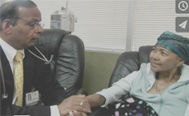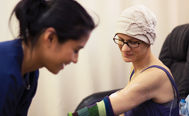 It’s no secret that lifestyle factors like diet, physical fitness, environment, and habits like smoking can play a pivotal role in both the onset and recovery for a number of cancers. While the ability to pinpoint a direct cause for the most common to the rarest forms of cancer remains elusive, there is a great deal of research and data suggesting that being physically fit and active can have both a preventative and therapeutic impact on a person’s physical, emotional, and mental well being – before, during, and after treatment.
It’s no secret that lifestyle factors like diet, physical fitness, environment, and habits like smoking can play a pivotal role in both the onset and recovery for a number of cancers. While the ability to pinpoint a direct cause for the most common to the rarest forms of cancer remains elusive, there is a great deal of research and data suggesting that being physically fit and active can have both a preventative and therapeutic impact on a person’s physical, emotional, and mental well being – before, during, and after treatment.
Whether that means activities like swimming, cycling, yoga, or even walking is up to the patient, and whatever feels most appropriate for their individual lifestyle and health profile. And while taking the time to fit regular exercise into a busy schedule can seem like a daunting and tedious task for people who are not already active exercisers, or who may already be dealing with the side effects of treatment, it can make have a positive effect before and after treatment.
Lowering Cancer Risk With Exercise
According to a comprehensive study conducted by the National Cancer Institute, data from a number of individual studies conducted in the United States and Europe suggests that individuals who engage in regular exercise saw their risk levels diminished by anywhere from 42 to 10 percent for a range of cancers.
The analysis included people who engaged in a range of physical activities, across a range of weight categories. Mild and moderate exercisers represented the lowest risk levels, but even overweight and obese participants benefited from some form of physical movement, like brisk walking several times a week.
The massive study included data from over 1 million participants, spanning an 11 year period. How much of a decrease did regular exercisers experience?
Lower breast cancer risk – 10%
Lower bladder cancer risk – 13%
Lower rectal cancer risk – 13%
Lower head and neck cancer risk – 15%
Lower colon cancer risk – 16%
Lower myeloma risk – 17%
Lower myeloid leukemia risk – 20%
Lower endometrial cancer risk – 21%
Lower stomach cancer risk – 22%
Lower kidney cancer risk – 23%
Lower lung cancer risk – 26%
Lower liver cancer risk – 27%
Lower esophageal cancer risk – 42%
While cancer is not always preventable, knowing that there are actionable steps that everyone can take, especially for individuals who are already genetically predisposed, or are at a higher risk level for certain cancers, is incredibly welcomed news.
Sitting is the New Smoking
In addition to the benefits that exercise and an active lifestyle contribute to cutting the risk for many types of cancer, (while also lowering the risk of obesity), experts have begun to study the effects that an increasingly sedentary lifestyle can have on long term health. With most people spending anywhere from 6-8 hours a day sitting at a desk, behind the wheel of a car, and at home on the couch bingeing on Netflix, the toll that prolonged sitting can take on the body and on cardiovascular health is just starting to come to light.
While regular exercise can help to significantly cut the risk of many forms of cancer, research suggests that prolonged sitting – spending hours on end in a seated position on a daily basis – can wreak havoc on our health, and actually increase the risk for certain forms of cancer in some cases.
Even with a long workout at the end of a long day at the office, the effects of sitting for hours can still have a negative impact on health. The reason seems to be associated with a buildup of glucose when the legs are immobile for long periods of time, which can increase the risk of diabetes and cardiac disease. Additionally, the research also suggests that a sedentary lifestyle can also increase the risk for certain types of cancer, mainly lung, endometrial, and colorectal.
In addition to getting regular exercise, people who spend several hours a day sitting either at work or with leisure activities are advised to stand up and take frequent breaks. If working at a standing desk is not an option, alternating between sitting and standing every 30 minutes, even to stretch in place will have more of an impact than running on a treadmill or hiking for an hour after spending several hours sitting in a chair without a break.
The good news is that it is never too late to get started. Consulting with physician to find the most appropriate fitness program, and finding an activity that is both challenging but manageable can offer physical, mental, and emotional benefits across the board.
Contact the Sarcoma Specialists in Los Angeles
For more information on diagnostic and treatment options for soft tissue sarcomas and rare connective tissue cancers, contact the Cancer Center of Southern California by calling 310-499-2690 to schedule an appointment today.
Next, read Tips for Safe and Healthy Holiday Travel During Cancer Treatment



